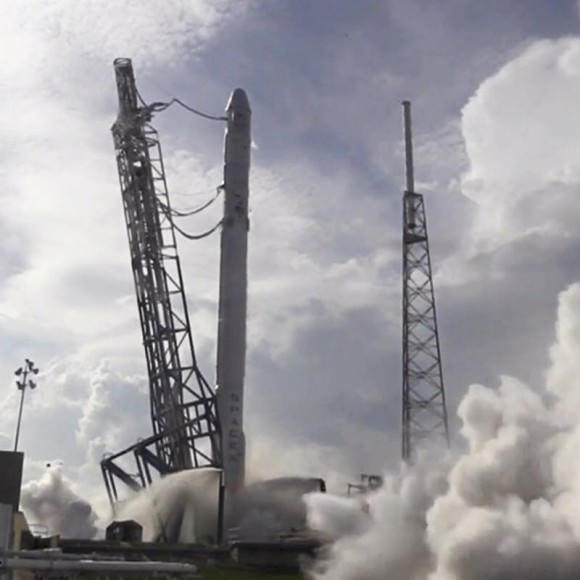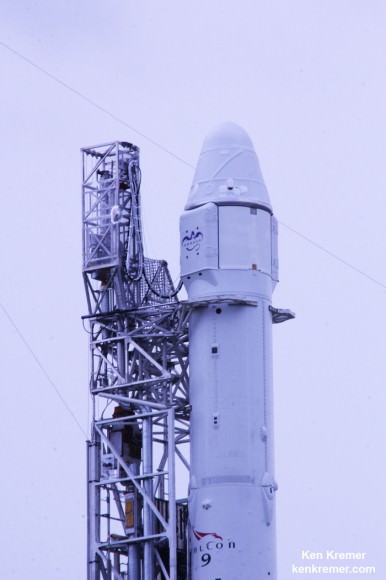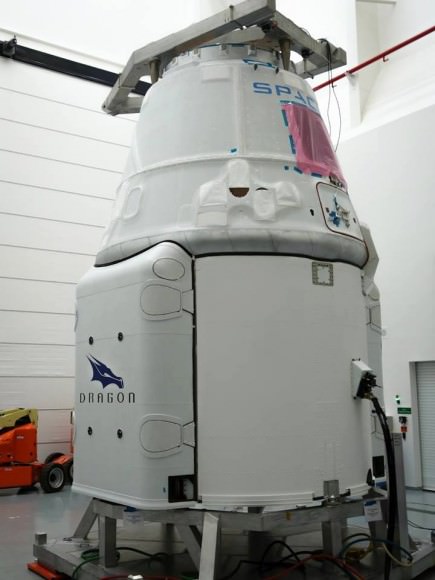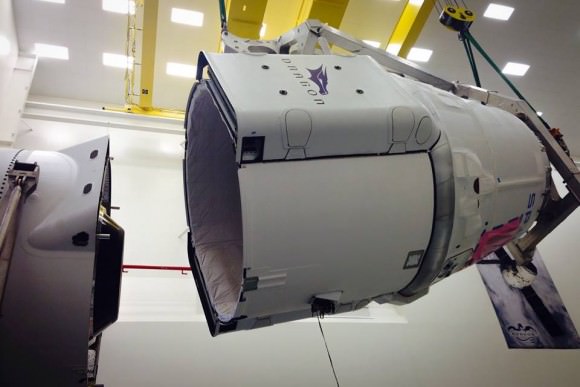KENNEDY SPACE CENTER, FL – Now just a day away, all systems are “GO” for blastoff of the next SpaceX Falcon 9 rocket carrying the Dragon CRS-6 cargo capsule on Monday, April 13, on a mission to the International Space Station (ISS) and a near simultaneous historic attempt to soft land the boosters first stage on a barge in a remote area of the Atlantic Ocean, hundreds of miles offshore from the US eastern seaboard.
In advance of Mondays launch attempt, SpaceX engineers successfully completed the practice countdown dress rehearsal and required static fire engine test this afternoon, Saturday, April 11, to ensure everything is ready with the rocket and first Stage Merlin 1-D engines for a safe and successful mission to the orbiting outpost.
The Dragon capsule has already been loaded with most of the cargo bound for the space station and was mated to the Falcon 9 booster earlier this week.
Although it is raining heavily now around the Florida Space Coast region along with multiple tornado warning threats, NASA and SpaceX officials are hopeful that weather conditions will clear sufficiently to permit Monday’s planned launch.
U.S. Air Force weather forecasters from the 45th Weather Squadron currently rate the chances of favorable conditions at launch time as 60 percent GO for liftoff of the sixth SpaceX commercial resupply services mission (CRS-6) to the ISS.

SpaceX and NASA are targeting blastoff of the Falcon 9 and Dragon CRS-6 spacecraft for Monday, April 13, slated at approximately 4:33 p.m. EDT from Space Launch Complex 40 at Cape Canaveral Air Force Station in Florida.
NASA Television plans live launch coverage starting at 3:30 p.m EDT: http://www.nasa.gov/multimedia/nasatv/index.html
SpaceX also plans live launch coverage beginning at 4:15pm EDT: www.spacex.com/webcast
The launch window is instantaneous, meaning that the rocket must liftoff at the precisely appointed time. Any delays due to weather or technical factors will force a scrub.
If all goes well with Mondays launch attempt, the Dragon spacecraft will rendezvous with the Earth orbiting outpost Wednesday, April 15, after a two day orbital chase.
In the event of a scrub for any reason, the backup launch day is 24 hours later on Tuesday, April 14, at approximately 4:10 p.m.
The Falcon 9 first stage is outfitted with four landing legs and grid fins to enable the landing attempt, which is a secondary objective of SpaceX. Cargo delivery to the station is the overriding primary objective and the entire reason for the CRS-6 mission.
The SpaceX plan is to direct the spent 1st stage on a precision guided rocket assisted descent from high altitude to accomplish a pinpoint soft landing onto a tiny platform in the middle of a vast ocean.
The ocean-going barge is known as the ‘autonomous spaceport drone ship’ (ASDS). It is being positioned some 200 to 250 miles offshore of the Carolina’s in the Atlantic Ocean along the rockets flight path flying along the US Northeast coast to match that of the ISS.
The ASDS measures only 300 by 100 feet, with wings that extend its width to 170 feet.

This marks the 2nd attempt by SpaceX to recovery the 14 story tall Falcon 9 first stage booster on the ASDS barge.
The first attempt in January during the CRS-5 mission was largely successful, as I wrote earlier at Universe Today, despite making a ‘hard landing’ on the ASDS. The booster did make it to the drone ship, positioned some 200 miles offshore of the Florida-Carolina coast, northeast of the launch site in the Atlantic Ocean. The rocket broke into pieces upon hitting the barge.
Overall CRS-6 is the sixth SpaceX commercial resupply services mission and the seventh trip by a Dragon spacecraft to the station since 2012.
CRS-6 marks the company’s sixth operational resupply mission to the ISS under a $1.6 Billion contract with NASA to deliver 20,000 kg (44,000 pounds) of cargo to the station during a dozen Dragon cargo spacecraft flights through 2016 under NASA’s original Commercial Resupply Services (CRS) contract.
Dragon is packed with more than 4,300 pounds (1915 kilograms) of scientific experiments, technology demonstrations, crew supplies, spare parts, food, water, clothing and assorted research gear for the six person Expedition 43 and 44 crews serving aboard the ISS.

The ship will remain berthed at the ISS for about five weeks.
The ISS cannot function without regular deliveries of fresh cargo by station partners from Earth.
Watch for Ken’s continuing onsite coverage of the CRS-6 launch from the Kennedy Space Center and Cape Canaveral Air Force Station.
Stay tuned here for Ken’s continuing Earth and planetary science and human spaceflight news.

………….
Learn more about SpaceX, Mars rovers, Orion, Antares, MMS, NASA missions and more at Ken’s upcoming outreach events:
Apr 11-13: “SpaceX, Orion, Commercial crew, Curiosity explores Mars, MMS, Antares and more,” Kennedy Space Center Quality Inn, Titusville, FL, evenings
Apr 18/19: “Curiosity explores Mars” and “NASA Human Spaceflight programs” – NEAF (NorthEast Astronomy Forum), 9 AM to 5 PM, Suffern, NY, Rockland Community College and Rockland Astronomy Club


Falcon-Dragon seems to be such a smooth and cheap little project compared to SLS-Orion. Every other week there’s a blog post here about some launch pad, barge, building, platform, tower, booster rockets, main shuttle engines, the world’s largest welding equipment and what next, which has to be reengineered for the SLS+Orion at great cost. Although it’s supposed to build upon existing Shuttle systems, while SpaceX starts from scratch. They even have a huge special building only for putting the launch abort tower on the Orion, while the Dragon2 simply uses its built in landing engines as launch abort. When SpaceX test launches their Grasshopper there’s only a pickup and a few containers and tank trailers around in the middle of a field. There are clever ways to do things, and there are clumsy ways.
SLS and Orion is deep space. Except for the capsule shape of the Orion, all technology has to be invented.
Orion is designed for deep space operations where you do not have real time telemetry like Apollo did.
SLS is going to become the a rocket that is even bigger than Saturn V and can launch 130 metric tonnes.
— “The massive 130-metric-ton-configuration will be the most
capable, powerful launch vehicle in history. Towering a staggering
384 feet tall, it will provide 9.2 million pounds of thrust
at liftoff and weigh 6.5 million pounds. It will be able to carry
payloads weighing 286,000 pounds to orbit. This configuration
will use the same core stage, with four RS-25 engines, as
previous configurations.”
SLS, if it happens, could send an Apollo style mission to the Moon, but it isn’t deeper space than that. Not without multiple launches that dock in LEO. And if a Falcon Heavy can take 2/3 of the payload mass to LEO as the SLS Block I can do, at a few percent of the cost, then the SLS has no advantage other than direct surface-to-surface launches of 2-3 astronauts Earth-to-Moon. And NASA has no plans to develop any lunar lander (Orion can only land in Earth’s oceans), sooo…
In 15 years or so when the SLS Block II is flying its first crew, SpaceX might very well have completed an even larger rocket very much cheaper. You speculate about the non-existing SLS, so the obvious answer is another speculation that another yet non-existing rocket very likely will be a much better alternative. SLS would be useful for a Moon program, worthless for a Mars mission, but NASA has no Moon mission planned, officially formally because they’ve already “been there, done that”. When the vague Moon mission was canceled a few years ago, SLS+Orion should also have been canceled.
The Chinese Long March 9 is now in early tech development, and is projected to achieve c 10- 11 million lbs of thrust with an LEO payload of 130 tons or so. It is planned to support human landing/base construction missions on/to the Moon and elsewhere, as well as enabling large space station elements for LEO/GEO.
Recently, several Chinese scientists have proposed the use of the 2020-2 multimodular space space station to test and develop key Solar Power Satellite technologies ( light weight panels, deployment systems, , energy beam transmission and much else), with a view to a 5 GW demo unit in or near 2030
THe major aims are final replacement of polluting fossil/uranium based fuels with a truly industrial scale inexhaustible ( or thereabouts!) clean energy system ( wind and terrestrial solar are judged inadequate for a major industrial power’s needs as Germany and others now know, to their cost)
A major benefit of SPS for China, and indeed the world would be an end to dependence on unstable often brutal and hostile regimes in the Middle East and a capricious Russia.
China has no reason, barring major socio-economic collapse, NOT to go down this route, as, among other things, China could arrive at a constructive leadership role in human development without firing a single shot.
On present form China has the longterm vision, is building up the necessary rocket, lunar and space station assets for lunar bases- which would convert the demo satellite sprogramme into a truly global energy system around mid century. It could also mop up financial over growth away from frenzied speculation into something positive , as well as giving China a more meaningful culture than crass consumerism can generate on its own ( a desire Mr Jiang Zemin voiced in his writings.
The Long March 9 would thus “kill several birds with one stone” and the whole shebang would cost a good deal less than a major Middle East or war for oil, with far more constructive results!
A rivalry between the West and China would be satisfactory result of a “big rocket race” with economic construction as a driver…
We can but hope….?
The Germans in WW2 could assemble a V2 Launch in the middle of a woods or between houses in a matter of hours today there is too much show before a launch and the costs are ouragious SpaceX are doing a great job compaired to NASA and I wish them all the best of success…
The V2 was intended to come down crashing and burning.
It also did not send 130 metric tonnes or humans into Lunar orbit.
Olaf Just in case you don’t know Von Braun was the chief Engineer on the V2 and he got NASA to the Moon, So put that in your pipe and smoke it 🙂 cowboy…
Von Braun did not create the Saturn V in a shed in the middle of the woods.
So the landing attempt will be made during daylight hours in the late afternoon or early evening. THAT should make for some good photo ops. – of history being made! Make it so!
GO Space-X!
Yes I wish them all the best it will be great if they can make it and film the landing…
Quote: .. “The first attempt in January during the CRS-5 mission was largely successful, as I wrote earlier at Universe Today, despite making a ‘hard landing’ on the ASDS [drone ship]. The booster did make it to the drone ship, positioned some 200 miles offshore of the Florida-Carolina coast, northeast of the launch site in the Atlantic Ocean. The rocket broke into pieces upon hitting the barge.”
From January report: .. The hard landing apparently was caused by a lack of hydraulic fluid in the final stages of the landing.
“Grid fins worked extremely well from hypersonic velocity to subsonic, but ran out of hydraulic fluid right before landing,” Musk tweeted.
“Upcoming flight already has 50% more hydraulic fluid, so should have plenty of margin for [the next] ‘landing’ attempt…”